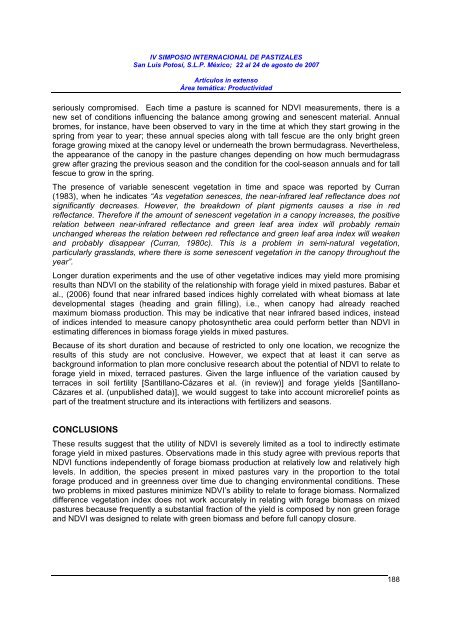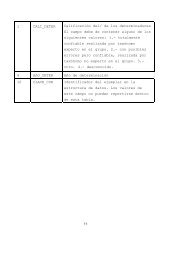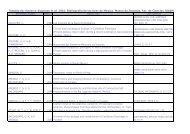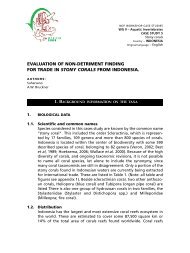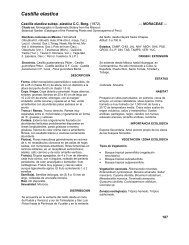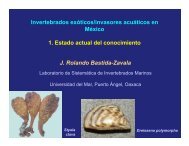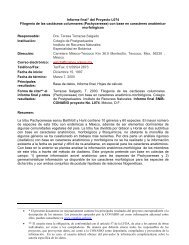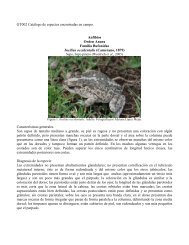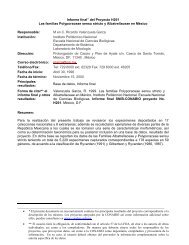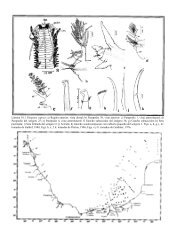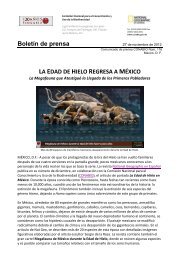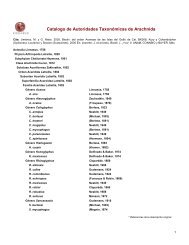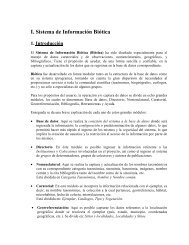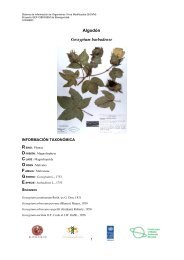ecosystem services to and from north american arid ... - Conabio
ecosystem services to and from north american arid ... - Conabio
ecosystem services to and from north american arid ... - Conabio
Create successful ePaper yourself
Turn your PDF publications into a flip-book with our unique Google optimized e-Paper software.
IV SIMPOSIO INTERNACIONAL DE PASTIZALES<br />
San Luis Po<strong>to</strong>sí, S.L.P. México; 22 al 24 de agos<strong>to</strong> de 2007<br />
Artículos in extenso<br />
Área temática: Productividad<br />
seriously compromised. Each time a pasture is scanned for NDVI measurements, there is a<br />
new set of conditions influencing the balance among growing <strong>and</strong> senescent material. Annual<br />
bromes, for instance, have been observed <strong>to</strong> vary in the time at which they start growing in the<br />
spring <strong>from</strong> year <strong>to</strong> year; these annual species along with tall fescue are the only bright green<br />
forage growing mixed at the canopy level or underneath the brown bermudagrass. Nevertheless,<br />
the appearance of the canopy in the pasture changes depending on how much bermudagrass<br />
grew after grazing the previous season <strong>and</strong> the condition for the cool-season annuals <strong>and</strong> for tall<br />
fescue <strong>to</strong> grow in the spring.<br />
The presence of variable senescent vegetation in time <strong>and</strong> space was reported by Curran<br />
(1983), when he indicates “As vegetation senesces, the near-infrared leaf reflectance does not<br />
significantly decreases. However, the breakdown of plant pigments causes a rise in red<br />
reflectance. Therefore if the amount of senescent vegetation in a canopy increases, the positive<br />
relation between near-infrared reflectance <strong>and</strong> green leaf area index will probably remain<br />
unchanged whereas the relation between red reflectance <strong>and</strong> green leaf area index will weaken<br />
<strong>and</strong> probably disappear (Curran, 1980c). This is a problem in semi-natural vegetation,<br />
particularly grassl<strong>and</strong>s, where there is some senescent vegetation in the canopy throughout the<br />
year”.<br />
Longer duration experiments <strong>and</strong> the use of other vegetative indices may yield more promising<br />
results than NDVI on the stability of the relationship with forage yield in mixed pastures. Babar et<br />
al., (2006) found that near infrared based indices highly correlated with wheat biomass at late<br />
developmental stages (heading <strong>and</strong> grain filling), i.e., when canopy had already reached<br />
maximum biomass production. This may be indicative that near infrared based indices, instead<br />
of indices intended <strong>to</strong> measure canopy pho<strong>to</strong>synthetic area could perform better than NDVI in<br />
estimating differences in biomass forage yields in mixed pastures.<br />
Because of its short duration <strong>and</strong> because of restricted <strong>to</strong> only one location, we recognize the<br />
results of this study are not conclusive. However, we expect that at least it can serve as<br />
background information <strong>to</strong> plan more conclusive research about the potential of NDVI <strong>to</strong> relate <strong>to</strong><br />
forage yield in mixed, terraced pastures. Given the large influence of the variation caused by<br />
terraces in soil fertility [Santillano-Cázares et al. (in review)] <strong>and</strong> forage yields [Santillano-<br />
Cázares et al. (unpublished data)], we would suggest <strong>to</strong> take in<strong>to</strong> account microrelief points as<br />
part of the treatment structure <strong>and</strong> its interactions with fertilizers <strong>and</strong> seasons.<br />
CONCLUSIONS<br />
These results suggest that the utility of NDVI is severely limited as a <strong>to</strong>ol <strong>to</strong> indirectly estimate<br />
forage yield in mixed pastures. Observations made in this study agree with previous reports that<br />
NDVI functions independently of forage biomass production at relatively low <strong>and</strong> relatively high<br />
levels. In addition, the species present in mixed pastures vary in the proportion <strong>to</strong> the <strong>to</strong>tal<br />
forage produced <strong>and</strong> in greenness over time due <strong>to</strong> changing environmental conditions. These<br />
two problems in mixed pastures minimize NDVI’s ability <strong>to</strong> relate <strong>to</strong> forage biomass. Normalized<br />
difference vegetation index does not work accurately in relating with forage biomass on mixed<br />
pastures because frequently a substantial fraction of the yield is composed by non green forage<br />
<strong>and</strong> NDVI was designed <strong>to</strong> relate with green biomass <strong>and</strong> before full canopy closure.<br />
188


